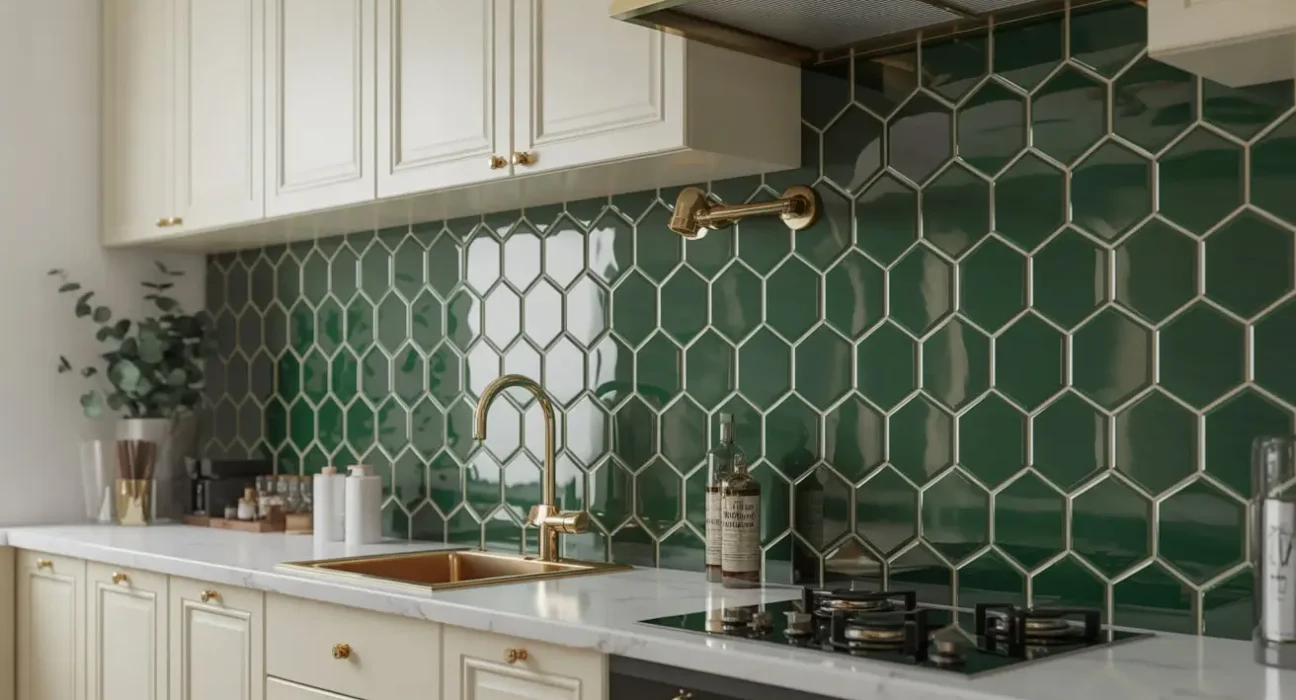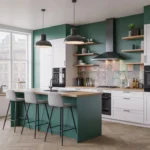Look, I get it—choosing a backsplash feels like committing to a relationship. You’re going to see this thing every single day, probably while you’re half-awake making coffee or stress-cooking at 10 PM. So why not make it gorgeous? Green backsplashes have absolutely exploded in popularity lately, and honestly, I’m here for it. They bring life, personality, and that chef’s-kiss level of sophistication that white subway tiles just can’t match anymore (sorry, not sorry).
I’ve spent way too much time scrolling through kitchen designs, and I’m about to share fifteen green backsplash ideas that’ll make your kitchen the envy of your entire Pinterest board. Whether you’re into subtle sage or bold emerald, there’s something here that’ll speak to your soul—and your design aesthetic.
Sage Green Subway Tile Backsplash
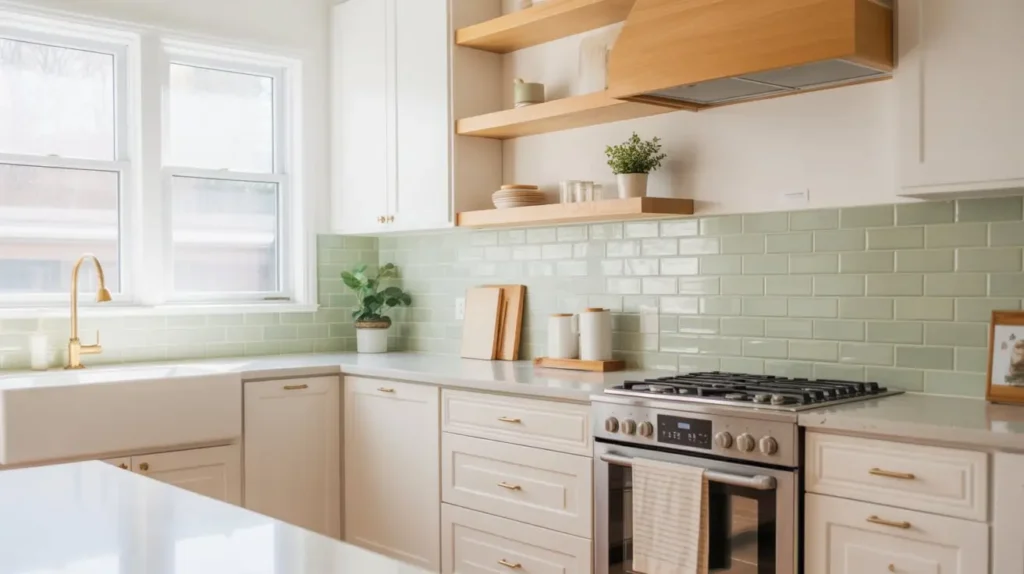
Let’s kick things off with the gateway drug of green backsplashes: sage green subway tiles. This option basically screams “I’m trendy but also timeless,” which is exactly the vibe most of us want in our kitchens.
Sage green brings that calming, earthy quality without overwhelming your space. I’ve seen this work beautifully in both modern farmhouse kitchens and sleek contemporary spaces. The subway tile format keeps things classic, while the color adds just enough personality to avoid boring territory.
Here’s what makes sage subway tiles brilliant:
- They pair incredibly well with white cabinets (classic combo)
- Warm wood tones love sage green—think butcher block countertops
- Brass or gold fixtures? Chef’s kiss
- They hide minor imperfections better than stark white tiles
The beauty of this option is its versatility. You can install them in traditional horizontal brick pattern, vertical stack, or even herringbone if you’re feeling spicy. IMO, the classic brick pattern with white grout gives you that clean, approachable look that’ll age like fine wine.
Emerald Herringbone Kitchen Backsplash
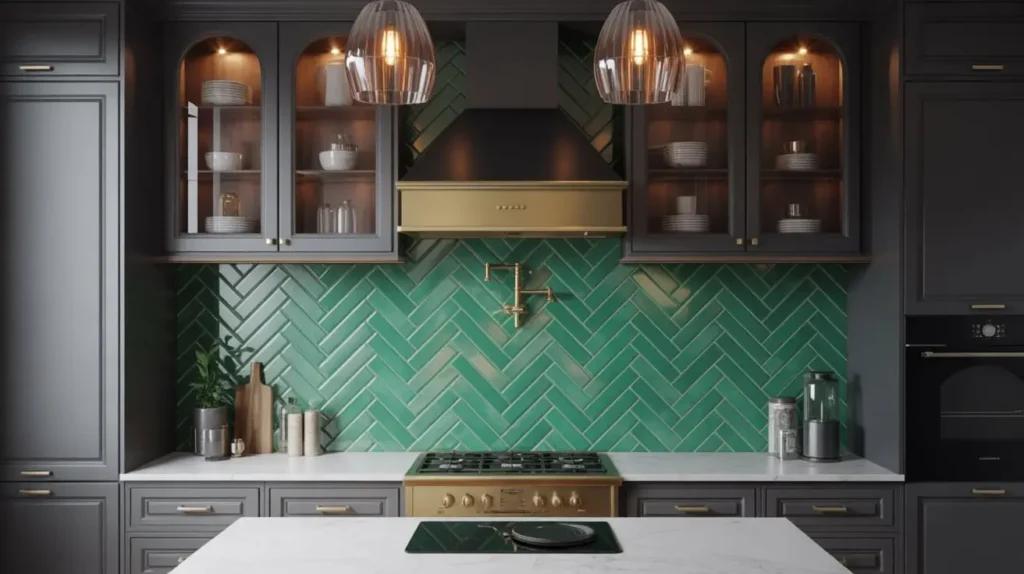
Want to make a statement? Emerald green in a herringbone pattern is your answer. This isn’t for the faint of heart—it’s bold, luxurious, and absolutely stunning when done right.
Emerald green brings serious drama and richness to your kitchen. The herringbone pattern elevates it from “nice backsplash” to “showstopping focal point.” I recently saw this in a friend’s kitchen paired with matte black cabinets and marble countertops, and I literally stood there staring at it for an awkward amount of time.
The key considerations for emerald herringbone:
- Works best as a focal point behind the stove or sink
- Needs adequate lighting to showcase the pattern properly
- Pairs beautifully with gold, brass, or copper fixtures
- Consider glossy finish for maximum light reflection
This design choice tells everyone you’re confident in your style decisions. It’s sophisticated without being stuffy, and it photographs like a dream (hello, Instagram-worthy kitchen). Just be prepared for guests to spend more time complimenting your backsplash than eating your food 🙂
Olive Green Moroccan Tile Design
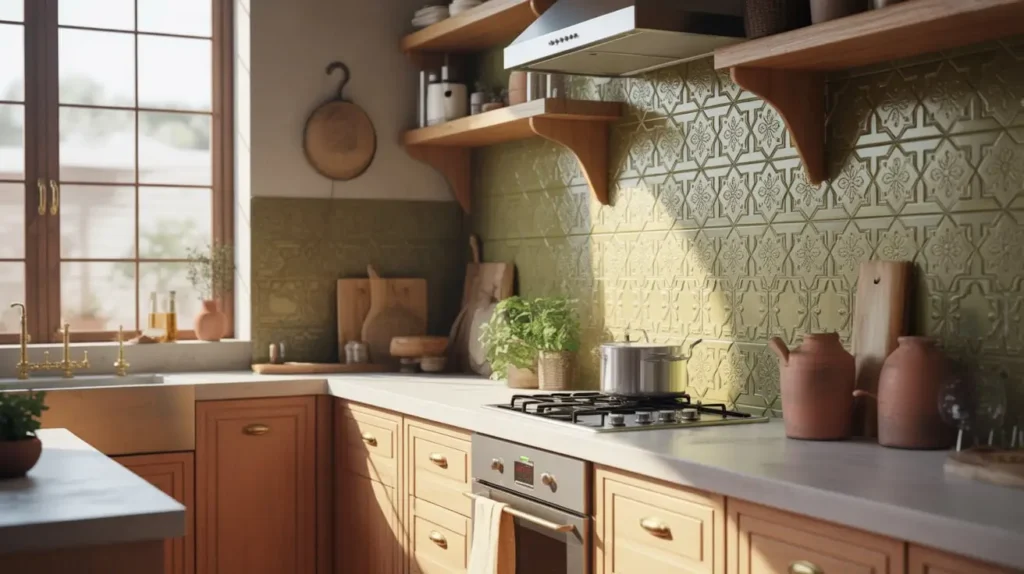
Ever wondered why Moroccan tiles make everything look expensive? Olive green Moroccan tiles combine intricate patterns with earthy tones, creating a backsplash that’s basically art you can clean.
Moroccan tiles bring incredible texture and visual interest. The olive green shade sits in that perfect middle ground—not too bright, not too dark—making it surprisingly versatile. These tiles typically feature geometric patterns or arabesques that add movement and depth to your kitchen walls.
What you’ll love about olive Moroccan tiles:
- Each tile becomes a tiny piece of art
- The patterns distract from splashes and stains (practical!)
- They work in both modern and traditional kitchens
- Create an exotic, worldly vibe without being over-the-top
I’d recommend using these strategically. A full wall might feel overwhelming, but the area behind your stove? Absolutely perfect. Pair them with simple, clean cabinetry to let the tiles shine. White or cream cabinets work wonderfully, as do natural wood tones.
Mint Green Glass Tile Accent Wall
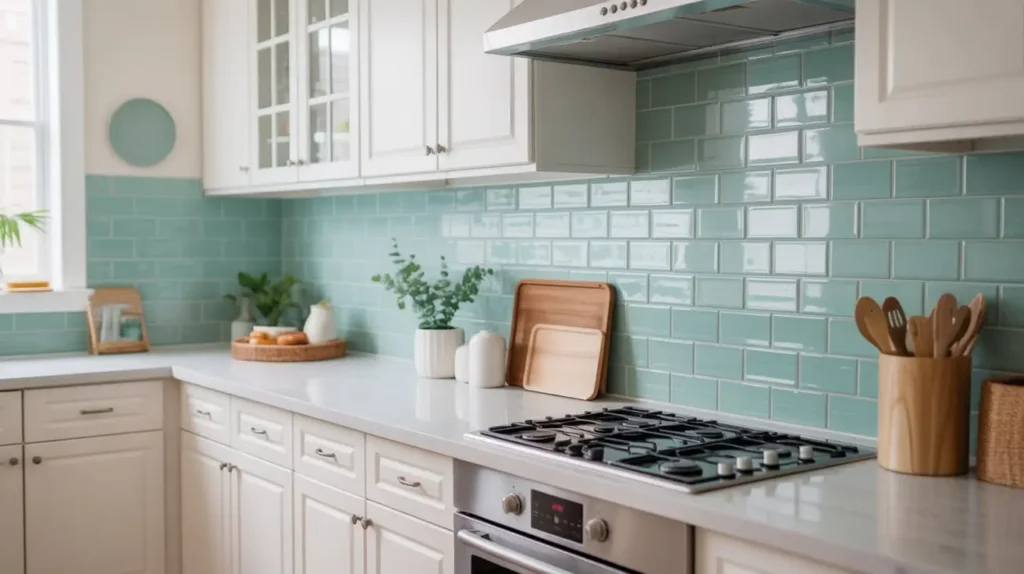
Mint green glass tiles give your kitchen that fresh, airy feeling that makes you want to actually spend time cooking instead of ordering takeout (revolutionary concept, I know).
Glass tiles have this magical quality where they catch and reflect light in ways ceramic just can’t match. Mint green specifically brings a retro-modern vibe—think 1950s diner meets contemporary chic. The translucent quality of glass creates depth, making your backsplash look almost three-dimensional.
Why glass tiles rock:
- Super easy to clean (grease wipes off like a dream)
- Reflect light, making small kitchens feel bigger
- The glossy finish adds instant sophistication
- Available in various sizes from tiny mosaics to subway-sized
FYI, glass tiles do require proper installation—you’ll want a white thinset so the adhesive doesn’t show through. But once they’re up, they’re practically bulletproof. Pair mint green glass with white or light gray cabinets for that crisp, clean aesthetic that never goes out of style.
Also Read: 15 Gorgeous Light Green Kitchen Ideas to Inspire You
Forest Green Marble Backsplash

Okay, let’s talk luxury. Forest green marble is the backsplash equivalent of wearing a tailored suit—it just makes everything look more expensive and put-together.
Natural marble brings unique veining and patterns that you simply cannot replicate with manufactured materials. Every slab tells its own story. Forest green marble typically features deep green backgrounds with white, gold, or even darker green veining running through it. This isn’t just a backsplash; it’s a legitimate investment piece.
The marble advantage:
- Absolutely unique—no two installations look identical
- Heat resistant (perfect behind stoves)
- Increases home value significantly
- Timeless elegance that transcends trends
Real talk: marble requires maintenance. You’ll need to seal it regularly, and acidic substances (looking at you, lemon juice and tomato sauce) can etch the surface. But if you’re willing to baby it a bit, the payoff is a kitchen that looks like it belongs in an architectural digest spread.
Green and White Geometric Pattern Tiles

Geometric patterns in green and white bring that perfect balance between playful and sophisticated. These tiles prove that you can have fun with your kitchen without sacrificing grown-up style.
Geometric tiles come in countless patterns—hexagons, diamonds, chevrons, quatrefoils, you name it. The green and white combination keeps things fresh and bright while adding serious visual interest. I’ve noticed these work particularly well in kitchens that might otherwise feel too plain or cookie-cutter.
Pattern considerations:
- Small-scale patterns work better in compact kitchens
- Large geometric designs make bold statements in spacious areas
- Consider the pattern’s orientation for visual flow
- White grout keeps the look clean; colored grout adds character
The genius of geometric patterns is how they add personality without requiring bright colors or unusual materials. A crisp geometric pattern in green and white feels modern, clean, and just complex enough to keep things interesting. Plus, they photograph incredibly well for all your “I cooked dinner” social media posts.
Soft Pastel Green Ceramic Backsplash
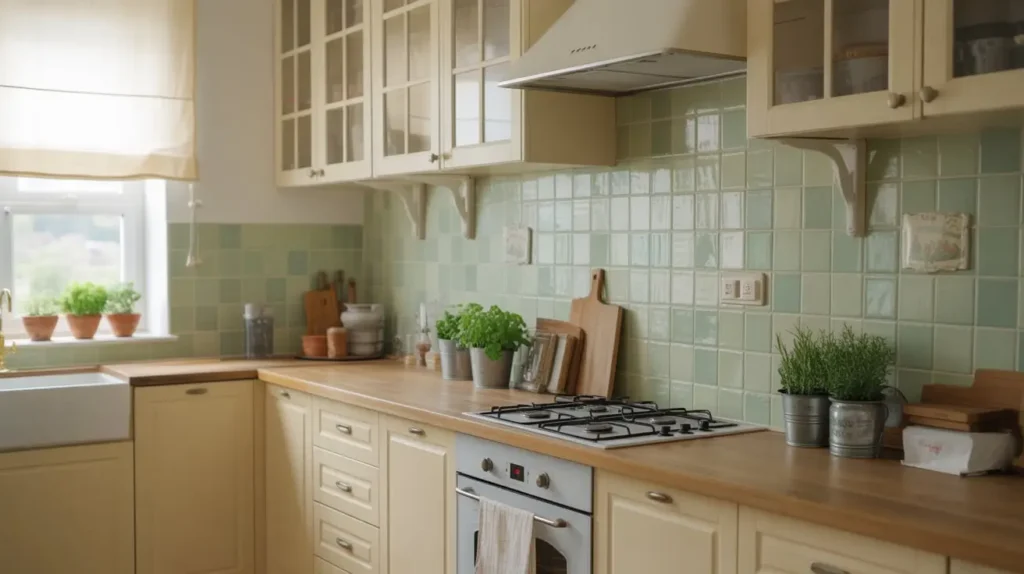
Sometimes you want color without the commitment of something bold. Soft pastel green ceramic tiles are like the perfect barely-there makeup—they enhance without overpowering.
Pastel green ceramics bring a gentle, soothing quality to kitchens. We’re talking seafoam, celadon, or pale pistachio shades that whisper rather than shout. These tones work beautifully in kitchens where you want a hint of color but need the space to feel open and airy.
Why pastel green works:
- Creates a calming, peaceful atmosphere
- Pairs with virtually any cabinet color
- Reflects light while adding subtle color
- Affordable compared to glass or stone options
- Easy to find in various tile formats
I love pastel green in kitchens with lots of natural light—it almost glows during golden hour. Pair it with white cabinets and warm wood accents for a Scandinavian-inspired look, or combine it with brass fixtures and marble countertops for something more luxe. Either way, you’re creating a space that feels both fresh and timeless.
Deep Teal-Green Mosaic Kitchen Wall

Ready to commit to color? Deep teal-green mosaic tiles deliver richness and complexity that’ll make your kitchen feel like a jewel box.
Mosaic tiles create incredible texture through their small-scale format. When you choose a deep teal-green, you’re working with a color that sits right between blue and green, giving you the best of both worlds. The mosaic format means you get subtle color variation across the wall, adding depth and interest.
Mosaic tile benefits:
- Small tiles mean fewer cuts needed around outlets
- Color variations create a dynamic, living surface
- Work beautifully on curved or irregular surfaces
- The busy pattern hides splashes and stains
This look works spectacularly with both light and dark cabinetry. White cabinets make the teal pop dramatically, while dark navy or charcoal cabinets create a moody, sophisticated atmosphere. Add some open shelving with colorful dishes or glassware, and you’ve got yourself a kitchen with serious personality.
Also Read: 15 Beautiful Green and White Kitchen Ideas with Cozy Vibes
Green Hexagon Tiles with Gold Grout
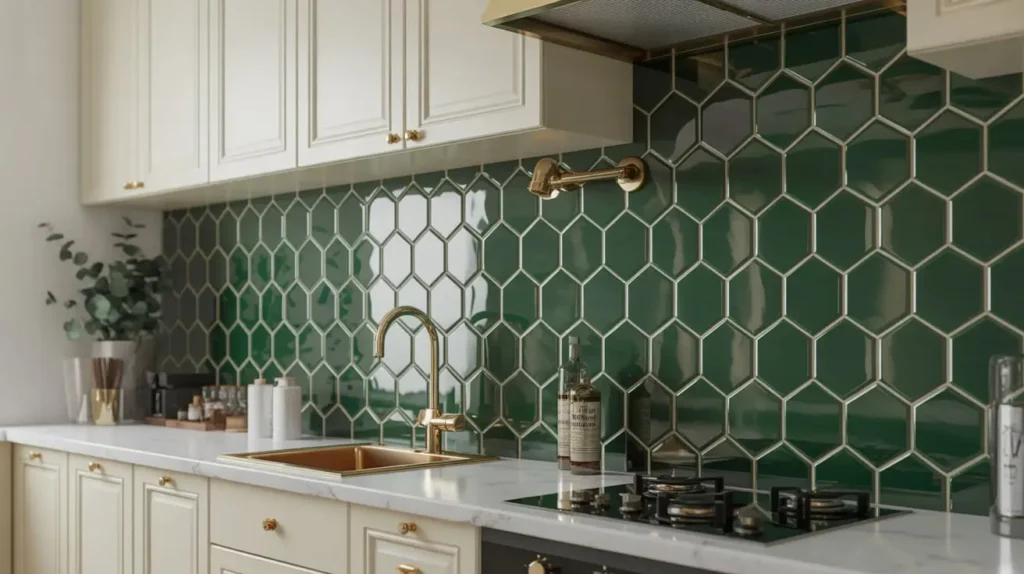
Want to know a secret? Green hexagon tiles with gold grout are the design move that makes people think you hired an expensive interior designer (when really you just have excellent taste).
Hexagon tiles have this geometric appeal that feels both modern and somewhat vintage—they were popular in the 1920s and they’re having a major moment again. Pair that shape with a gorgeous green shade and gold grout, and you’ve created something truly special.
Why this combination slays:
- Gold grout adds instant luxury and warmth
- Hexagons create a honeycomb pattern that’s naturally eye-catching
- The geometry adds movement without being chaotic
- Green and gold is a historically luxe color combination
I’ve seen this work in shades from pale sage to deep forest green. The gold grout ties everything together and catches the light beautifully. Fair warning: choosing gold grout is a commitment—you can’t just wipe away stains as easily as with white grout—but the visual impact is absolutely worth the extra cleaning care.
Glossy Dark Green Brick-Style Backsplash

Glossy dark green brick-style tiles bring that perfect blend of traditional and contemporary. Think British pub meets modern kitchen, and somehow it just works.
The brick-style format (similar to subway tiles but often thicker and more dimensional) gives you classic appeal, while the dark green and glossy finish modernize the whole look. These tiles practically glow when they catch the light, creating a sophisticated, polished appearance.
Dark green glossy tile advantages:
- Creates drama without overwhelming the space
- The gloss finish reflects light, preventing the dark color from making the space feel small
- Easy to clean—glossy surfaces resist staining
- Works in both traditional and ultra-modern kitchens
Pair these beauties with light-colored cabinets for contrast, or go full moody with dark cabinetry and brass fixtures. Either way, you’re creating a kitchen with serious personality. The glossy finish is key here—it takes what could be a heavy, dark surface and makes it feel fresh and intentional.
Light Green Herringbone Peel-and-Stick Tiles

Not everyone owns their kitchen or wants to commit to a permanent installation. Light green herringbone peel-and-stick tiles are the solution for renters and commitment-phobes everywhere.
Peel-and-stick technology has come incredibly far. These aren’t your grandma’s contact paper disasters—modern peel-and-stick tiles look remarkably realistic and stay put until you want them gone. The herringbone pattern in a light green shade gives you that designer look without the designer price tag or permanent installation.
Peel-and-stick perks:
- Install them yourself in an afternoon (seriously)
- Remove them without damaging walls
- Perfect for renters wanting to personalize their space
- Fraction of the cost of traditional tile installation
- Easy to replace if damaged
I’ll be honest—they won’t fool a tile expert up close. But from normal viewing distance? They look fantastic. Choose a light green shade to keep things bright and fresh. This option lets you test out whether you actually like living with a green backsplash before committing to permanent tile.
Green Terrazzo Backsplash with Natural Stone

Green terrazzo brings that artisanal, handcrafted vibe that’s absolutely on-trend right now. This isn’t your school cafeteria terrazzo—modern versions are sophisticated, subtle, and stunning.
Terrazzo consists of chips of marble, quartz, granite, or glass set in concrete or resin. When you choose a green terrazzo, you typically get a pale green or cream base with flecks of darker green, white, gray, or even gold. The result is a surface that’s visually interesting without being busy.
Why terrazzo deserves consideration:
- Incredibly durable and long-lasting
- Each section is unique
- The speckled pattern hides imperfections and stains
- Bridges the gap between modern and retro aesthetics
- Available in slabs or tiles
Terrazzo works beautifully in kitchens going for that mid-century modern or contemporary look. Pair it with simple cabinetry and let the backsplash be the star. The natural stone components mean you’re bringing actual nature into your kitchen, which somehow makes the space feel more grounded and intentional.
Sage and Wood Mixed Texture Backsplash

Ever thought about mixing materials? Sage green tile combined with wood elements creates a backsplash that’s equal parts unexpected and absolutely gorgeous.
This approach typically involves using sage green tiles for most of the backsplash while incorporating wood shelving, wood accent strips, or wooden tile sections. The combination of cool sage and warm wood creates balance and visual interest that single-material backsplashes just can’t achieve.
Mixed material magic:
- Adds dimensional interest beyond flat tile
- The wood brings warmth to balance the cool green
- Creates built-in display areas if using shelving
- Shows off your design creativity
- Makes your kitchen genuinely unique
I’ve seen this executed with floating wood shelves installed over sage tile, wood beams running horizontally through the tile, and even alternating sections of wood and tile. The key is keeping proportions balanced—you want enough of each material to make the combination intentional, not accidental-looking.
Green Zellige Tiles with Rustic Finish

Zellige tiles are having a major moment, and green versions bring that perfect artisanal, handcrafted quality that mass-produced tiles simply cannot match.
Zellige tiles are hand-cut Moroccan tiles with slightly irregular shapes and a distinctive glazed finish. Each tile is unique, with subtle variations in color and slight dimensional differences. When you choose green zellige, you get a backsplash that looks like it came from a European artisan’s workshop.
Zellige characteristics:
- Handmade quality means no two tiles are identical
- The uneven surface catches light beautifully
- Color variations add depth and authenticity
- The rustic finish feels sophisticated, not sloppy
- Pairs wonderfully with both modern and traditional kitchens
These tiles work spectacularly in kitchens going for that organic, lived-in luxury vibe. They’re the opposite of sterile perfection—they celebrate imperfection and craftsmanship. Pair green zellige with natural wood, stone countertops, and simple fixtures to create a kitchen that feels collected and intentional rather than designed in a single shopping trip.
Two-Tone Green Ombre Backsplash Design

Ready for something truly unique? A two-tone green ombre backsplash transitions from one green shade to another, creating a gradient effect that’s artistic and unexpected.
This approach involves starting with one shade of green (say, a pale mint) at the top of your backsplash and gradually transitioning to a different shade (like sage or forest green) at the counter level. You achieve this by carefully selecting tiles in graduated shades or by using smaller mosaic tiles that blend the colors seamlessly.
Ombre backsplash considerations:
- Requires careful planning and tile selection
- Works best with professional installation for seamless transitions
- Creates a focal point that’s genuinely one-of-a-kind
- The gradient adds visual height to your kitchen
- Pairs best with simple, solid-colored cabinetry
This isn’t the easiest option to execute, but the results are absolutely show-stopping. I’ve seen versions that go from pale seafoam to deep teal, and others that transition from lime to olive. The key is choosing shades that blend naturally rather than creating harsh color jumps. When done right, it looks like an intentional piece of art rather than a backsplash.
Bringing It All Together: Choosing Your Perfect Green Backsplash
So which green backsplash should you choose? Honestly, it depends on your personal style, your kitchen’s existing elements, and how bold you’re feeling on any given day.
If you’re new to color, start with sage green subway tiles or soft pastel ceramics—they’re forgiving and versatile. Feeling confident? Go for that emerald herringbone or deep teal mosaic. Want something truly unique? Try the ombre design or zellige tiles for that handcrafted quality.
Consider these final factors:
- Your cabinets: Light cabinets pair with any green shade; dark cabinets need careful color coordination
- Your countertops: Busy countertops need simpler backsplashes; simple counters can handle complex tile patterns
- Your lighting: Natural light shows true colors; artificial light can shift green tones
- Your commitment level: Permanent tile vs. peel-and-stick changes your options
- Your budget: Glass and marble cost more; ceramic and peel-and-stick cost less
The beautiful thing about green backsplashes is that you really can’t go wrong. Green brings life, freshness, and personality to kitchens in a way that neutral colors simply don’t. Whether you choose a barely-there pastel or a bold emerald statement, you’re creating a kitchen with character and style.
Remember, your kitchen should make you happy. If a particular green shade or tile pattern makes you smile when you look at it, that’s probably the right choice—regardless of what’s “trending” or what design rules say you “should” do. After all, you’re the one who’ll be staring at it every morning while waiting for your coffee to brew.
Now go forth and create the green kitchen backsplash of your dreams. Your boring white tile walls will never know what hit them.
And hey, when your friends inevitably ask where you got your design inspiration, you can just casually say you “threw it together” while secretly knowing you made a meticulously planned, absolutely gorgeous choice. That’s the real designer move right there.



